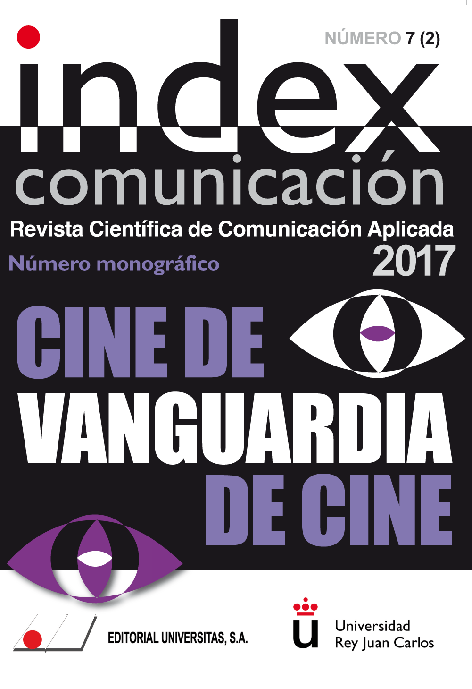Transversalities Painting-Cinema: the concept of ‘the pictorial’ in the cinema of the first avant-gardes
Keywords:
painting, cinema, transversally, the pictorial, communication, transmissionAbstract
The aim of this article is to verify the intense relationship that has been maintained between the cinematographic medium and the artistic Avant-gardes, especially with painting. In order to do so, we analyse how the latter –after its historical interest in representing the movement– looks at the cinema, being influenced by it, which we can demonstrate through the examples that will follow. But the most interesting thing is perhaps to show how, after the mentioned relation, a certain experimental cinema ends up welcoming the concept of “the pictorial” for its discursive purposes, as well as for its processes of realization. Experiences that, from the dialogues around the light that both media share, lead us to the debate on their locations relative to the time; as synchronous communication means or diachronic transmission means.
Metrics
References
Barthes, R. (1992): Lo obvio y lo obtuso. Barcelona: Paidós.
Bonitzer, P. (2007): Desencuadres. Cine y pintura. Buenos Aires: Santiago Arcos.
Breton, A. (2001): Manifiestos del surrealismo. Buenos Aires: Argonauta.
Debray, R. (2001): Introducción a la mediología, Barcelona: Paidós.
Hueso, Á. L. (1983): El cine y la historia del siglo XX. Santiago de Compostela: Universidad de Santiago de Compostela.
Hueso, Á. L. (1986): “El hecho cinematográfico: sus características”. En Anthropos Revista de Documentación Científica de la Cultura nº 58.
Huyghe, R. y Rudel, J. (1978): El arte y el mundo moderno, 1880-1920, Vol. 1. Barcelona: Planeta.
Labarrére, A. Z. (2009). Atlas del Cine. Madrid- España: Akal.
Mercader A. y Suárez, R. (eds.) (2013). Puntos de encuentro en la iconosfera. Interacciones en el audiovisual. Barcelona: Universitat de Barcelona.
Mitry, J. (1974): Historia del cine experimental. Valencia: Fernando Torres.
Olmo, S. B. (2005): “La renovación de la pintura sin pintura. La situación en España”. Catálogo de exposición: Pintar sense pintar, Lleida: Centro de Arte La Panera.
Ortiz, Á. y Piqueras, M. J. (1995): La pintura en el cine. Cuestiones de representación visual. Barcelona, Paidós.
Parkinson, D. (1998): Historia del cine. Barcelona: Destino.
Romaguera i Ramió, J y Alsina Thevenet, H. (ed.) (1998). Textos y manifiestos del cine. Madrid: Cátedra.
Sánchez-Biosca, V. (2004). Cine y vanguardias artísticas. Conflictos, encuentros, fronteras. Barcelona: Paidós.
Schobert, W. (1989) El cine alemán de vanguardia de los años veinte. Múnich: Goethe-Institut.
Sorlin, P. (1996). Cines europeos sociedades europeas, 1939-1990. Barcelona: Paidós.
Souriau, É. (1998): La Correspondencia de las Artes, México: Fondo de Cultura Económica, México.
Sus Montañés, J. (2003): Hacia una filosofía de lo pictórico, estudio sobre la evolución en la representación de las percepciones visuales. Zaragoza: Institución Fernando el Católico.
Tejeda, C. (2008): Arte en fotogramas. Cine realizado por artistas, Madrid: Cátedra.
Uscatescu, J. (1975): Idea del arte. Madrid: Reus.
Published
How to Cite
Issue
Section
License
Authors who submit to this journal agree to the following terms:
Authors retain copyright and ensure the magazine's right to be the first publication of the work as licensed under a Creative Commons Attribution-NoComercial 4.0 International License that allows others to share the work with an acknowledgment of authorship of the work and the initial publication in this magazine, with no commercial purpose.
Authors can establish separate additional agreements for non-exclusive distribution of the version of the work published in the magazine (for example, to an institutional repository or publish it in a book), with an acknowledgment of its initial publication in this journal.
It allows and authors are encouraged to disseminate their work electronically (eg, in institutional repositories or on their own website) prior to and during the submission process, as it can lead to productive exchanges, as well as a citation more early and most of the published work (See The Effect of Open Access).















